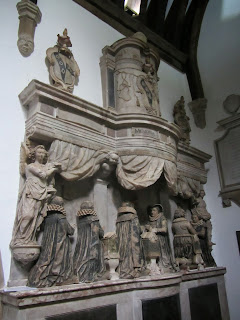Chief among them is this extravaganza commemorating Lady Margaret Savile, who died at the age of 73 in 1631. She is in the centre, facing her third and most distinguished husband, Sir Henry Savile, Mathematician, Astronomer, Historian of Science, translator (in his lodgings at Merton, the '5th committee', responsible for the Gospels, Acts of the Apostles, and the Book of Revelations in the King James Bible met, Savile's knowledge of Greek making him the only layman involved in the translation).
We can perhaps imagine the two of them are praying over open copies of the text he helped produce. Savile had died in 1622, Margaret had erected a monument to him in Merton College Chapel. The brochure available in the church cites Elias Ashmole as saying that there was formerly an infant in a cradle in front of them. The monument says she had two sons by Savile, who both died young.
To the left in this matriachal frieze are the figures on two of Margaret's daughters: Lady Anne Carleton (from her first marriage to George Garrard) and Lady Elizabeth Sidley, her daughter by Savile.
To the right are the figures of Lady Francis Harison, youngest of her daughters by her first husband, and her husband Sir Richard Harison of Hurst. The whole monument is here because Margaret wanted 'to deposite her body in the place where living she had found soe much content & soe sweet a repose in her age' - she had lived with this couple in Hurst in her final years.
The solidity of these figures, their prayerful calm, is offset by a great swagger of marble drapery, with angels and cherubs pulling aside or lifting the curtains to disclose this undramatic scene of family prayer:
Studded here and there are the shields that spell out the dynastic stuff, and further cartouches crown the whole structure, this monument that is almost a building
Urns, shields, tassels, strapwork, fringes, inscriptions, curlicues, ribbonwork, scrolls, swags: it is the very height of early 17th century taste, that taste for which the quip that 'less is more' never had any meaning: more is more.
It is Lady Margaret's own monument. It commemorates her three husbands, but depicts just the last (I guess it must be the case that while men can freely have themselves depicted between wives, a widow could not have a line-up of her late spouses without some indecorum of effect). Sir George Savile is not here given any particular allusions to point to his achievements in learning, the angels are not indicated to be allegorical. This stony splendour is a fossil of her taste. The impression one has of matrilineage is perhaps wrong: three daughters are indeed present, but we should remember that the top order of the monument did originally commemorate one of the lost infant sons, and the remaining five of Margaret's nine children (two male, three female) are in smaller and now headless effigies below the rank of inscriptions:
.









No comments:
Post a Comment